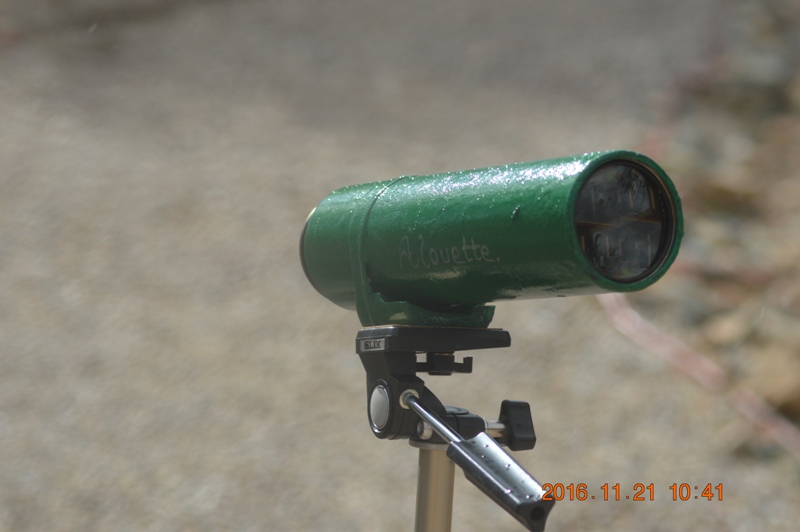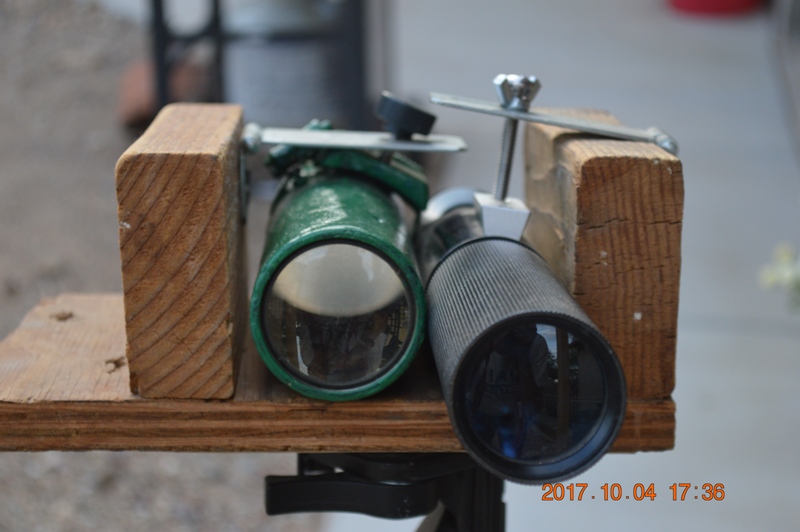by David Levy
- Created: Friday, October 20 2017 21:20

One of the Alouettes as it appears after it was painted green in 2016. It provides beautiful, wide-field views of the Milky Way. Photograph by David Levy.
As a youngster growing up in Montréal, Canada, I always enjoyed the children’s song Alouette. It was a little ditty about a small lark whose loud chirp woke little children early every morning, and each stanza referred to a different part of the bird. As I grew up, I prepared for the graduation of Westmount High School in 1966. By this time I was passionate about astronomy and I was active in almost every branch of observing, including a daily check on the Sun to count the number of sunspots from day to day. In order to make this particular project a bit more convenient, I used a very small pocket-sized telescope that I named Alouette. During recess or lunchtime, I would take the telescope outside the school, set it up on the steps and project its image of the sun onto a piece of paper. I even still have a record of two of those observing sessions from so long ago:
1296S: Wednesday, March 2, 1966/1230-1235/Partly cloudy/ Westmount High School/Alouette/ Sunspot II: 0 spots.
1297S2/1515-1520/Clear/Westmount High School/Alouette/ Sunspot-II.
After I graduated Westmount in the spring of 1966, I put Alouette away someplace safe, and it has since been lost. However, around the same time I stored the original Alouette, I purchased a small finder telescope, which did service for many years before I decided to use it as an independent telescope; I named this second telescope Alouette in honor of my earlier interest.
It turned out that this was the third Alouette. Last summer I was reminded of yet another Alouette I bought in 1978 and which I named Alouette II. I lent that telescope to Angelika Hackett, a friend from Queen’s University where I was studying for my MA at the time. Ika held onto the telescope for many years and returned it to me after this summer’s eclipse of the Sun. I use the two remaining Alouettes on many clear nights. They are both too small to be my major instruments but they make great travel and quick-look telescopes.
Why am I writing about tiny, almost useless telescopes that I had when I was very young? Because they are far from useless. They provide great views of the Moon and of wide fields of the Milky Way. It doesn’t matter what you use to enjoy the sky. Going out for a few minutes on a hazy, moonlit night may not be the best way to enjoy the night sky, but a small telescope-like Alouette will give you a very good view of the Moon. The slightly larger one, Alouette III, has a wide field that gives unsurpassed views of wide areas of the Milky Way. The Alouettes even remind me of what I had to work with when I was young and just starting out. The two Alouettes bring me back to my youthful days in Montréal when my life stretched endlessly ahead of me, I could sing about a lark, and I had plenty of time to reach for the stars.

Both Alouettes mounted in a wooden frame. The black one is better for the Moon.
Photograph by David Levy.







